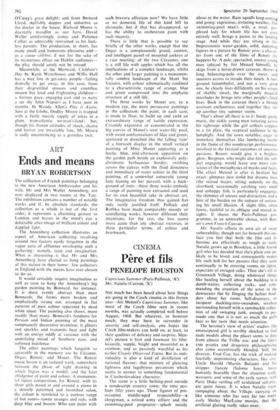ART
Ends and means
BRYAN ROBERTSON
The collection of French paintings belonging to the new American Ambassador and his wife, Mr and Mrs Walter Annenberg, are now displayed in two rooms at the Tate. The exhibition contains a number of notable works and if, by absolute standards, the collection as a whole is not of the first order, it represents a charming gesture to London and leaves in the mind's eye a delectable after-image of brilliant colour and dappled light.
The Annenberg collection illustrates an aspect of American collecting revolving around two factors easily forgotten in the vague aura of affluence enveloping such a gathering: namely, taste and imagination. What is interesting - is that Mr and Mrs Annenberg have elected to hang paintings of this nature in their home : few collectors in England with the means have ever chosen to do so.
It would certainly require imagination as well as taste to hang the Annenberg's big garden painting by Bonnard, for instance. It is more evenly abstract than most Bonnards, the forms more broken and emphatically strung out, arranged in flat patterns of pure colour separated by dead white space. The painting also shows, more readily than many, Bonnard's fondness for Persian and Indian painting of the most sumptuously decorative invention: it glitters and sparkles and transmits heat and light with an energy oddly at variance with the underlying mood of Southern ease, and softened indolence.
The other paintings which languish so agreeably in the memory are by Cezanne, Degas, Renoir, and Monet. The Renoir music lesson is an isolated work, somewhere between the phase of tight drawing in which Ingres was a model, and the later effulgence of paint and colour. A monumen- tal figure composition, for Renoir, with its three girls posed at and around a piano in a densely patterned and furnished salon, the colour is restricted to a curious range of hot tones—tawny oranges and reds, with deep blue and brown. Who can paint with such bravura affection now? We have little or no domestic life of this kind left to chronicle; but if that has disappeared, so has the ability to orchestrate paint with such majesty.
There is little that is possible to say briefly of the other works, except that the Degas is a conspicuously grand, austere, and intelligent pastel of mounted jockeys at a race meeting; of the two Cezannes, one is a still life with apples which has all the implications of a complex landscape, whilst the other and larger painting is a monumen- tally sombre landscape of the Mont Ste Victoire, with colour schematically confined to a characteristic range of orange, blue and green compressed into the emphatic structure of a still life.
The three works by Monet are, to a modern eye, the most persuasive paintings in the collection: the paint, in each case, is made to float, to build up and yield an extraordinary range of tactile expression. Creamily expansive or concentrated in the big canvas of Monet's own water-lily pool, with weird confrontations of lilac and green; spattered or drenched like the falling 'rain' of a firework display in the small vertical painting of Mme Monet appearing as a hectic, blue, mid-afternoon apparition on the garden path beside an explosively poly- chromatic herbaceous border; swishing across the canvas with the fluid directness and immediacy of water colour in the third painting, of a somewhat autocratic young lady leaning on her parasol, with a back- ground of trees—these three works embody a range of painting now extracted and used for its own beautiful sake in abstract art. The imaginative freedom thus gained has only rarely justified itself. Pollock and Rothko have made comparably moody or scintillating works, however different their intentions; for the rest, the loss seems more acute than any abstract victories, in these particular terms, of colour and brushwork.








































 Previous page
Previous page